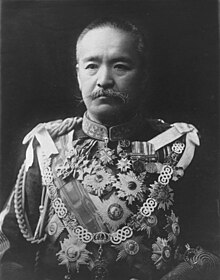Katsura Taro
Katsura Tarō ( Japanese 桂 太郎 ; born January 4, 1848 in Hagi ; † October 10, 1913 in Tokyo ) was a Japanese general , politician and the 11th, 13th and 15th Prime Minister of Japan .
Life
Katsura was born in 1848 in Hagi in the fiefdom of Chōshū (now Yamaguchi Prefecture ) into a samurai family and began his career fighting on the side of the imperial troops in the Boshin War that led to the Meiji Restoration . He showed such talent that he was sent to Germany (1870–1873) at state expense to study strategy and tactics . Later he was deployed several times as a military attaché at the Berlin embassy. After his return to Japan he was appointed Deputy Minister of the Army under yama Iwao in 1886 . His political ascent was also supported by Yamagata Aritomo .
In 1891 he was given command of the 3rd Division , which he led in the First Sino-Japanese War from 1894 to 1895. He undertook a memorable march in the middle of winter from the northeast coast of the Yellow Sea to Haicheng . Eventually he occupied Niuchwang and allied himself with the 2nd Army, which moved up the Liaodong Peninsula . For these services he received the title of vice count ( shishaku ) after the war . He was the second governor general of Taiwan from June 2, 1896 to October 1896 .
From 1898 he served as Minister of the Army in several governments until he became Prime Minister himself in 1901. He held this post for four and a half years, a record at the time. During his first term in office, Japan began to emerge as a major Asian power. Milestones were the Anglo-Japanese Alliance of 1902 and the victory over Russia in the Russo-Japanese War in 1904/05. For his diplomatic successes, Katsura was honored by King Edward in 1905 as Knight Grand Cross of the Order of the Bath and was raised by the Tennō in 1902 to the rank of count ( hakushaku ) and in 1907 the rank of margrave ( kōshaku ) . Due to widespread dissatisfaction with the Portsmouth Treaty , Katsura resigned as Prime Minister in early 1906.
In Katsura's second term as prime minister from 1908 to 1911, the final annexation of Korea took place in 1910, after a protectorate treaty had already been concluded in 1905 . From August 1911 until his reappointment as Prime Minister in December 1912, he was the keeper of the seals ( Naidaijin ) . At the same time he was accepted into the circle of Genrō in 1911 and raised to prince ( kōshaku ) .
His brief third term as Prime Minister coincided with the political crisis following the death of Emperor Meiji . From his political opponents from the Rikken Seiyūkai , the majority party in the lower house , his reappointment was viewed as part of a conspiracy by the Genrō to overturn the constitution. Faced with a “vote of no confidence” and large demonstrations, Katsura tried to get the new Tennō to intervene. His attempt to create his own power base in parliament by founding the Rikken Dōshikai came too late. He lost the vote, which resulted in the first successful "motion of no confidence" in Japanese history, and resigned in February 1913. A few months later he succumbed to cancer. The party he founded later became part of the Kenseikai .
Katsura can be seen as the main exponent of conservatism in Japan. He strictly adhered to the doctrine that ministers were only personally responsible to the Tennō and in no way to parliament . This kept him far from political parties, and only his gift for tact and reconciliation enabled him to govern on such principles.
His terms as Prime Minister were 11 (June 2, 1901– January 7, 1906), 13 (July 14, 1908– August 30, 1911) and 15 (December 21, 1912– February 20, 1913).
Web links
- Exhibition of the Japanese parliamentary library with portraits and short biographies of important Japanese personalities of the modern age (English / Japanese)
- Wikisource: 第三 次 桂 内閣 に 対 す る 内閣 不 信任 上奏 決議案 提出 及 び 趣 旨 説明 (Japanese, excerpt from the Reichstag minutes ; introduction and justification of the resolution on a report to the Tennō ( jōsō ) about suspicion in the 3rd Katsura cabinet; the "Motion of no confidence" of February 5, 1913 in the plenum of the lower house of the Reichstag)
- Newspaper article about Katsura Tarō in the 20th century press kit of the ZBW - Leibniz Information Center for Economics .
Individual evidence
- ↑ Honoray Knights and Dames at Leigh Rayment's Peerage
| personal data | |
|---|---|
| SURNAME | Katsura Taro |
| ALTERNATIVE NAMES | 桂 太郎 (Japanese) |
| BRIEF DESCRIPTION | Japanese general and politician; 11th, 13th and 15th Prime Ministers of Japan |
| DATE OF BIRTH | January 4, 1848 |
| PLACE OF BIRTH | Hagi |
| DATE OF DEATH | October 10, 1913 |
| Place of death | Tokyo |
